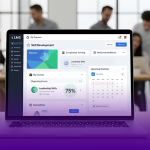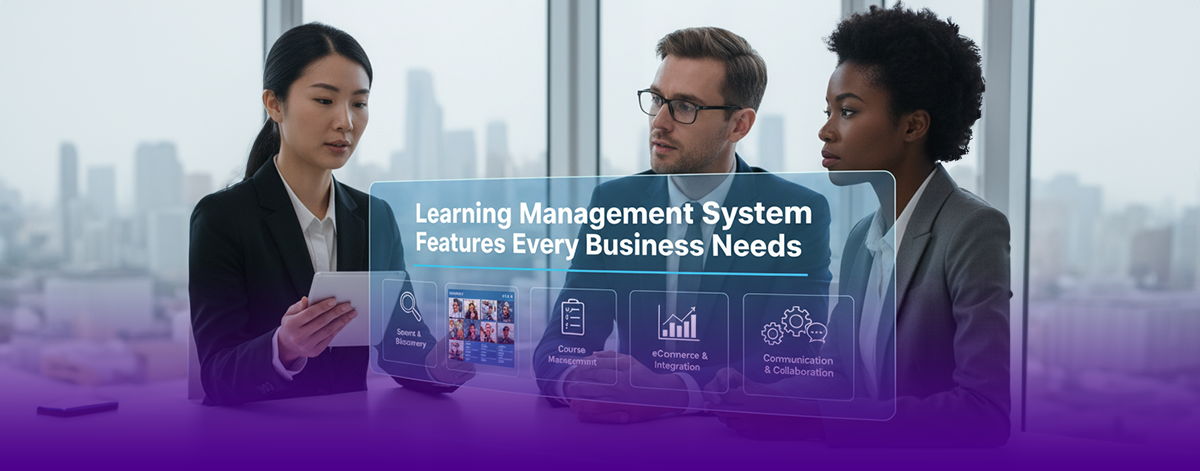
A Corporate LMS for Employee Training and Development
October 10, 2025
Best Employee Onboarding Software for 2025
October 10, 2025The way employees learn at work has changed more in the last five years than in the previous two decades. With technology evolving rapidly and businesses facing constant change, training programs can’t remain static. Organizations now need scalable, flexible, and engaging platforms that help employees build skills and grow with the business.
An LMS provides a digital hub for creating, delivering, and tracking training. But the actual value of an LMS depends on the learning management system features it offers. Not all systems are the same, and choosing the right ones can make the difference between average training and a thriving learning culture.
In this article we’ll explore must-have LMS features, discuss key LMS capabilities, and explain how learning management tools help organizations not only meet today’s needs but also prepare for the future of work.
Why Learning Management System Features Matter
An LMS is more than a repository of courses; it’s the foundation for workforce learning and development. The right learning management system features should:
- Make learning accessible anytime, anywhere.
- Provide personalized experiences to keep employees motivated.
- Track progress with data and analytics.
- Scale as the business grows.
For employees, this means learning is smoother and more engaging. For organizations, it means better results, increased retention, and a workforce ready for tomorrow’s challenges.
Must-Have LMS Features
When businesses invest in an LMS, certain features are non-negotiable. Let’s look at the must-have learning management system features every organization should prioritize.
- User-Friendly Design: An LMS should be easy to navigate. If the platform feels complicated, learners lose interest quickly. A clean and intuitive interface ensures both learners and administrators spend less time struggling with the system and more time focusing on training.
- Mobile Learning Capabilities: Employees are increasingly on the move. Whether they’re remote, hybrid, or in the field, they need training that works across devices. An LMS with strong mobile learning support enables employees to learn anytime, anywhere. Example: A sales rep accessing a product refresher course on their smartphone before meeting a client.
- Personalized Learning Paths: Every employee’s role and skill needs are different. Personalization is now a key LMS capability. With AI-driven recommendations and customizable learning paths, an LMS can deliver the right content to the right learner at the right time. This ensures learning feels relevant, which leads to higher completion rates and better outcomes.
- Integration with Business Tools: Training doesn’t work in isolation. Your LMS should integrate with HR systems, CRMs, collaboration platforms like Slack and Microsoft Teams, and even third-party content providers. These integrations streamline workflows and allow for unified reporting across platforms.
- Robust Reporting and Analytics: Data is one of the most substantial advantages of digital learning. Modern learning management tools should provide dashboards, reports, and analytics that track employee progress, identify skill gaps, and measure the effectiveness of training programs. With this data organizations can make informed decisions about where to invest in employee development.
- Gamification for Engagement: Learning doesn’t have to be boring. Gamification elements such as points, badges, leaderboards, and progress bars make training more engaging. Example: A leaderboard encouraging friendly competition among employees during compliance training.
- Compliance Management: For industries where regulations are critical such as healthcare, finance, or manufacturing, compliance features are a must. Automated reminders, certification tracking, and audit-ready reports help organizations stay on top of requirements without extra manual effort.
- Content Authoring and Management: A robust LMS should allow organizations to create and update courses quickly. Built-in authoring tools along with support for SCORM or xAPI ensure that learning materials are interactive, multimedia-rich, and easy to adapt.
- Social and Collaborative Learning: Learning is collaborative. Discussion forums, peer-to-peer feedback, and group projects create space for knowledge-sharing. These learning management tools make employees feel connected and encourage continuous learning.
- Scalability and Flexibility: An LMS should grow with the business. Cloud-based solutions are beneficial as they offer scalability without heavy infrastructure costs. Whether you’re adding new learners, expanding globally, or adopting new training formats, scalability ensures the LMS adapts along the way.
Key LMS Capabilities That Drive Growth
Beyond features, the broader LMS capabilities shape how well an organization can leverage the platform.
- Faster Onboarding: A user-friendly LMS cuts onboarding time significantly, helping new hires become productive in weeks rather than months.
- Upskilling and Reskilling: As jobs evolve, employees need new skills. Personalized learning paths and analytics make reskilling smoother and more effective.
- Retention and Engagement: Employees stay longer in organizations that invest in their growth. With engaging and personalized learning experiences, retention rates can rise by 30–50%.
- Performance Insights: Analytics give leaders a clear picture of workforce strengths and weaknesses, allowing training programs to target needs.
- Future Readiness: The right LMS can adapt to emerging technologies like AI, VR, and skill-mapping dashboards, ensuring organizations remain competitive in the long run.
Learning Management Tools That Make a Difference
Within an LMS, specific learning management tools play a critical role in shaping the learning journey. Some examples include:
- Course Libraries: Give learners easy access to structured training.
- Assessments and Quizzes: Measure progress and reinforce learning.
- AI-Driven Recommendations: Suggest next steps for continuous growth.
- Communication Tools: Reminders, notifications, and messaging keep learners engaged.
These tools transform learning into an ongoing, engaging process rather than a one-time event.
How Learning Management System Features Prepare You for the Future
Work is changing faster than ever. Many of tomorrow’s jobs don’t exist today. This makes investing in the right learning management system a strategic decision, not just a technology purchase. Future-focused LMS platforms come equipped with:
- AI for adaptive learning.
- Skill dashboards for tracking workforce growth.
- Analytics for predictive insights.
- Integrations that bring together learning and performance data.
These features ensure organizations actively shape their future.
Final Thoughts
The future of work is about people who are ready to learn, adapt, and grow. An LMS with the right features does more than deliver training; it builds confidence, sparks curiosity, and creates a culture where growth feels natural.
When organizations invest in these must-have LMS features and thoughtful LMS capabilities, they give their employees a sense of purpose and belonging. And that’s what truly prepares a business for tomorrow.
With Tenneo’s AI-powered LMS, this vision becomes reality. It brings together personalization, intelligence, and ease of use to create learning experiences and other learning management system features that feel supportive rather than structured, inspiring rather than overwhelming.
Because at the end of the day, learning should feel less like a task and more like an opportunity to thrive. And that’s the journey Tenneo helps you create.
Contact our experts today to build a stronger, future-ready organization where both people and business thrive.



